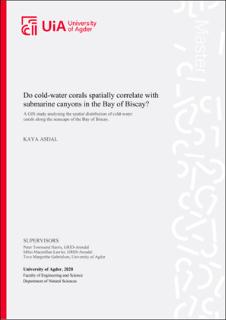| dc.contributor.author | Asdal, Kaya | |
| dc.date.accessioned | 2020-09-22T10:26:46Z | |
| dc.date.available | 2020-09-22T10:26:46Z | |
| dc.date.issued | 2020 | |
| dc.identifier.citation | Asdal, K. (2020) Do cold-water corals spatially correlate with submarine canyons in the Bay of Biscay? : A GIS study analysing the spatial distribution of cold-water corals along the seascape of the Bay of Biscay (Master's thesis). University of Agder, Kristiansand. | en_US |
| dc.identifier.uri | https://hdl.handle.net/11250/2678989 | |
| dc.description | Master's thesis in Coastal ecology (BIO501) | en_US |
| dc.description.abstract | The seascape of the Bay of Biscay is a mysterious place. It is located to the west of France and the north of Spainand is often defined as well-differentiated geomorphological unit. The continental margin of the BoB is incised with many submarine canyons and is also thought to be a hotspot for cold-water corals.Unfortunately, it is an area under high anthropogenic pressure where intense fishing activity, bottom trawling especially, is causing major disturbances to benthic habitats such as cold-water corals. Cold-water corals have been well studied along the European margin and have more frequently been recorded in the northeastAtlantic than any other place in the world. They are often found along the heads of shelf-incised submarine canyons that offer suitable conditions for cold-water corals.This study is a Geographical Information Systemsanalysis with the objectives of (1) understanding the spatial distribution of cold-water corals along the seascape of the Bay of Biscay, (2) the spatial correlation between cold-water corals and submarine canyons, and (3) how well geomorphic features and benthic habitats are included in management measures of the region. Data includes the EMODnet bathymetry grid from 2018 with a resolution of 100 meters, a global cold-water coral dataset from WCMC and a global map of marine protected areas from protectedplanet.net. The results show that the majority ofcold-water coral observations are located along the continental slope compared to the shelfand the abyss. In addition, the occurrence of CWCs is ~50% greater on continental slope areas outside of canyons compared to within canyons. Lastly, cold-water corals and submarine canyons are spatially well-covered by protected areas, but geomorphic features and benthic habitats arenot properly included in the framework of the protected areas. This leaves them vulnerable to anthropogenic pressures. Further expansion of knowledge on geomorphic features and benthic habitats along the ocean floor is vital for successful conservation ofthe planet’s seascape. | en_US |
| dc.language.iso | eng | en_US |
| dc.publisher | University of Agder | en_US |
| dc.rights | Attribution-NonCommercial-NoDerivatives 4.0 Internasjonal | * |
| dc.rights.uri | http://creativecommons.org/licenses/by-nc-nd/4.0/deed.no | * |
| dc.subject | BIO501 | en_US |
| dc.title | Do cold-water corals spatially correlate with submarine canyons in the Bay of Biscay? : A GIS study analysing the spatial distribution of cold-water corals along the seascape of the Bay of Biscay | en_US |
| dc.type | Master thesis | en_US |
| dc.rights.holder | © 2020 Kaya Asdal | en_US |
| dc.subject.nsi | VDP::Matematikk og Naturvitenskap: 400::Zoologiske og botaniske fag: 480::Marinbiologi: 497 | en_US |
| dc.subject.nsi | VDP::Matematikk og Naturvitenskap: 400::Zoologiske og botaniske fag: 480::Zoogeografi: 486 | en_US |
| dc.source.pagenumber | 46 | en_US |

